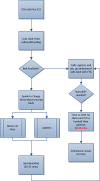Response Time in the Transport of Pediatric Patients to a Tertiary Critical Care Unit
- PMID: 35720870
- PMCID: PMC9197356
- DOI: 10.1097/pq9.0000000000000558
Response Time in the Transport of Pediatric Patients to a Tertiary Critical Care Unit
Abstract
Introduction: Various barriers delay the process of patient transfer to critical care units. We implemented quality improvement methods to decrease the time required for interhospital transfer of critical care patients. As a result, we aimed to decrease the time from initial transfer call to specialized transport team arrival at the referring hospital from 150 minutes to <40 minutes over 2 years.
Methods: Quality improvement initiative monitoring the length of transport time of 245 patients transferred from referral hospitals to a tertiary pediatric intensive care unit for 31 months from March 2013 to October 2015. We reviewed preexisting transport protocols and identified barriers to the timely arrival to the pediatric intensive care unit. We implemented 3 interventions: a transport information line serving as a central communication center to coordinate the transport process between all stakeholders, the formation of a specialized pediatric transport team, and a training program. We collected transport response time data and monitored the impact of interventions via statistical process control charts.
Results: There was a significant decrease in the length of the time course pre- and postintervention. We noted a special cause to decrease in time from referral hospital call to arrival of our transport team by 76% from 150 minutes to 36 minutes. In addition, the statistical process chart revealed a stable and effective process without significant shifts above the process mean as early as 3 months postintervention.
Conclusions: By improving our transport services with additional resources and people, we have improved the efficiency of patient transport between institutions.
Copyright © 2022 the Author(s). Published by Wolters Kluwer Health, Inc.
Figures
References
-
- Orr RA, Felmet KA, Han Y, et al. . Pediatric specialized transport teams are associated with improved outcomes. Pediatrics. 2009;124:40–48. - PubMed
-
- Vos GD, Nissen AC, H M Nieman F, et al. . Comparison of interhospital pediatric intensive care transport accompanied by a referring specialist or a specialist retrieval team. Intensive Care Med. 2004;30:302–308. - PubMed
-
- Kunkel SA, Sinkin RA. Challenges of pediatric medical transport in the 21st century health-care landscape. Chest. 2007;132:1113–1115. - PubMed
-
- Ramnarayan P, Polke E. The state of paediatric intensive care retrieval in Britain. Arch Dis Child. 2012;97:145–149. - PubMed
LinkOut - more resources
Full Text Sources
Research Materials
Miscellaneous




